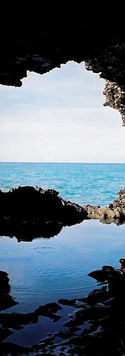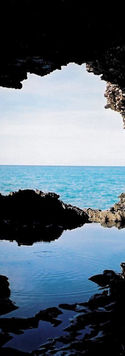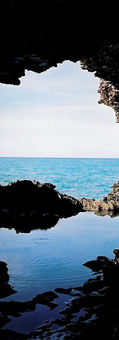
Summer School
for Stockholm
DANCE MOVEMENT THEATRE
7 DAY COURSE
STOCKHOLM SWEDEN

21st
Celebration
EVENING DANCE
HAMILTON HOUSE
BRISTOL - UK

The Flower Drum
2019
4 DAY DANCE INTENSIVE
CORNWALL
UK

The River That Finds
Us
1 YEAR FOUNDATION COURSE
CORNWALL
UK
RESOURCES
WILDERNESS
Spiderflower moved on to a period of working in remote and wild landscapes.
Arrival was often by chance, usually following a call for one to one work, where I found myself in places that were epic, breathtaking - even overwhelming in their beauty . . . but were never on my radar so I did not have conscious intent at the time to 'go to a place to develop Spiderflower in a specific way'.
Snowdonia and Barbados played key roles, and by travelling the road, working quietly - with more focus on stillness, listening and direct contact with the land for sustained periods of time - something else was developing within that process.
I have often said the work knows itself. There seems to be an underlying intelligence where it knows its direction - and arrives where it needs to be. So much of Spiderflower's journey has been about listening and following, it has been a great teacher around co-creativity and working in partnership - in a way that is more than about people alone.
The Wilderness period overlapped and worked in tandem with classes and courses, it brought in a new dimension where a deeper level of focus fell on the active and sustained dialogue between body and earth.
As a result, Spiderflower developed considerably, with the Wilderness period being a crucial step along the way.
NOTES & OBSERVATIONS


Movement: Rowan Jacqueline // Photography: © Gemma Burleigh Photography 2012. All rights reserved.

Movement: Rowan Jacqueline // Photography: © Gemma Burleigh Photography 2012. All rights reserved.

Movement: Rowan Jacqueline // Photography: © Gemma Burleigh Photography 2012. All rights reserved.

Movement: Rowan Jacqueline // Photography: © Gemma Burleigh Photography 2012. All rights reserved.

The effects of working in Wilderness filtered into Spiderflower in a number of ways that were,
at the time, subtle and inconspicuous. Only after a long period of observation have those effects become clear through repetition.
EARTH-WORK
Earth-work underpins Spiderflower's approach. There is only a certain amount we can do in the studio with regard to 'connecting'. There comes a time where we must step onto the earth itself. Wilderness means doing just that - and staying there for extended periods of time.
The period within Wilderness brought a true realisation of how intelligent, complex and powerful the earth is in her own right and is perfectly capable of facilitating dialogue and/or transformation.
The skill of 'getting out of the way' - in order to let the earth do her work is a crucial, and sometimes difficult to acquire. There is much to be said about the alchemy that occurs simply by being and resting in a place. The body is receptive, will absorb and will understand the earth's language - as this is the substance it is made of. This creates shifts on a cellular level that do effect the entire being in positive and profound ways.
Wilderness brought about a deep trust of this process. Earth-work is now integrated into Spiderflower's practice as an essential part of its make-up.
THE POWER OF SIMPLICITY + STAYING CLOSE TO THE BONE
There are lessons in simplicity here too.
In response to Spiderflower being in an extended process of development, a pattern followed where Spiderflower was continually simplified. I kept stripping it to the bone again and again, repeatedly over years - back to its central intent of working solely between the body / earth axis which in turn distilled its form.
In this way, Spiderflower is very neutral. Yet, humans do love to over-complicate and over-analyse things. It's also natural to want to 'bring in' ways of doing from previous trainings, but this tends to create diversion. The greatest challenge is to stay entirely present in the dialogue occurring between body and earth. Nothing more. Nothing else. That's it.
I found the simpler and more direct the approach, the more powerful the work would become. So a real discipline is needed for complete focus and commitment to the subject matter at hand - that is the conversation between body and earth.
This level of simplicity can turn people off. It sounds far too easy. But it is not. It can been immensely challenging - because it will provide an exact mirror. The approach acts as a gateway to a world that we do not ordinarily see, understand or appreciate. One that is not short of a living library, that is as complex and unending as it is breathtaking.
Such is the power in simplicity.
THE DANCE FORM + DEVELOPMENT
In Wilderness, the body absorbs and drinks all this in. It is a process of osmosis.
Time spent on the land takes awhile to filter through the body and into movement - how this shows up on the dance floor is a steady, gradual shift in a dancers technique, quality and presence.
Movement begins to truly echo the landscape where connected energy trembles through the fibre of the being, literally like another dimension, as it expresses through movement.
Once those conversations take place between body and earth, they never go away. Something is instilled in us, is physically woken and becomes part of how we move. It is there as a quality, a presence and a communication between the seen and unseen.
In motion, rather than being nebulous - this brings about a crystal clear precision within movement, a real clarity and depth. Spiderflower works with the principle that all energy follows a pattern and rhythm. When the body becomes receptive enough and sensitive enough to truly engage with, follow and translate this - we are then entering into a different movement form entirely.
IN THE STUDIO + PHOTOGRAPHER GEMMA BURLEIGH
During this period I met Spiderflower's photographer, Gemma Burleigh and began the work of capturing Spiderflower through still photography.
My relationship with Gemma is another real blessing, and like the creative relationship with Kirby and Afra a special alchemy occurs when we work together. She has an ability to simply - understand - Spiderflower in motion, which translates straight to film. To date Gemma has covered Portfolio for Earth, Slow Time and Crow: Earth + Air.
Landscape Image Above: Snowdonia © Hefin Owen - 2014. Creative Commons License. //
Dance Photography: Gemma Burleigh © 2012. All rights reserved.
MIRRORS + THE CRISIS OF SEPARATION
The process of observing Spiderflower unfold as a body of work over such a long period of time holds up a stark mirror. One that, with particular regard to climate change - needs to be taken note of.
It is a mirror that reflects the extent to which human beings have become separate from the earth, and the devastating impact this has.
This mirror reflects how living in a separate state from the natural environment creeps into and underpins relationship with self, the wider relationship with family, friends and social circles, to a culture at large and whole countries - effecting political, economical and ecological structures - and indeed is, as far as I can see, root cause to the urgent issues we as a global community face around climate change.
Separation diminishes and restricts. Energetically, it creates a short-circuit as we are dis-connect from life-giving forces that nourish and sustain us - we think we have to live in isolation, and so a pressurised cycle comes into effect as an individual tries to draw from internal resources alone without reaching beyond this. This downward spiral continues to deplete over the long term - quite simply because we are not 'plugged-in'. It acts like quick-sand, as the more an individual struggles to get out of it, the harder it can become - until solid ground is found.
The great problem is we don't know we are dis-connect, until we start to get a taste of what its like to begin the process of reconnection and the difference this makes. Humans tend to endure. We just don't realise how destructive the condition of separation actually is. When we do, it is (with patience and hard work) possible to reverse.
Separation is a condition that is at epidemic proportion.
It threatens the human race and thousands of other species with extinction - in how we are and act because of it. The earth will survive, and work it out in time. But unless we as humans wise-up and act-up very fast, the issue of separation could catalyse the end. These are strong words, but I am not alone in saying this. Spiderflower - can - offer significant, steadfast and positive structures to deal with this situation, which can pass on to future generations who will be left to deal with the fall out. It is our duty, if nothing else, to at least try.
Over the 20 years Spiderflower has been in development, observation sees as an individual re-builds bridges between body and earth, a shift which is ultimately expansive and creative will most often take place.
Changes seen again and again within Spiderflower's work effect not only a dancer in movement - which is the clearest mirror of all - but filter through to their personal choreography (how an individual 'puts it together' - emotionally, mentally, spiritually, sexually, physically), onto relationships, work and the wider relationship with the whole.
World-views change. People become centred, it effects the imagination, emotional stability and general sense of well-being, the creative centre opens and will often send a dancer on a path that is fluid and works for them with energy and passion.
For artists, regardless of what discipline they follow - the body is the tool through which they work and once in a state of connection, we find an artist is nourished, enabled. The process opens out their expression, giving grounding and depth.
All this, in turn, effects the relationship with the world we live in - enabling us to connect and give-back in a way that is also life-giving so contributes to the well-being of the whole to create a positive cycle, that in time sustains itself.
The Wilderness period has been crucial to Spiderflower's development, has contributed to fundamental ethos and a significant deepening to the work.
Landscape Images - This Section: Barbados © Rowan Jacqueline 2002.
Dance Photography: Gemma Burleigh © 2012. / The Sea - (below) Rob Purday © 2016.
All Rights Reserved.






































